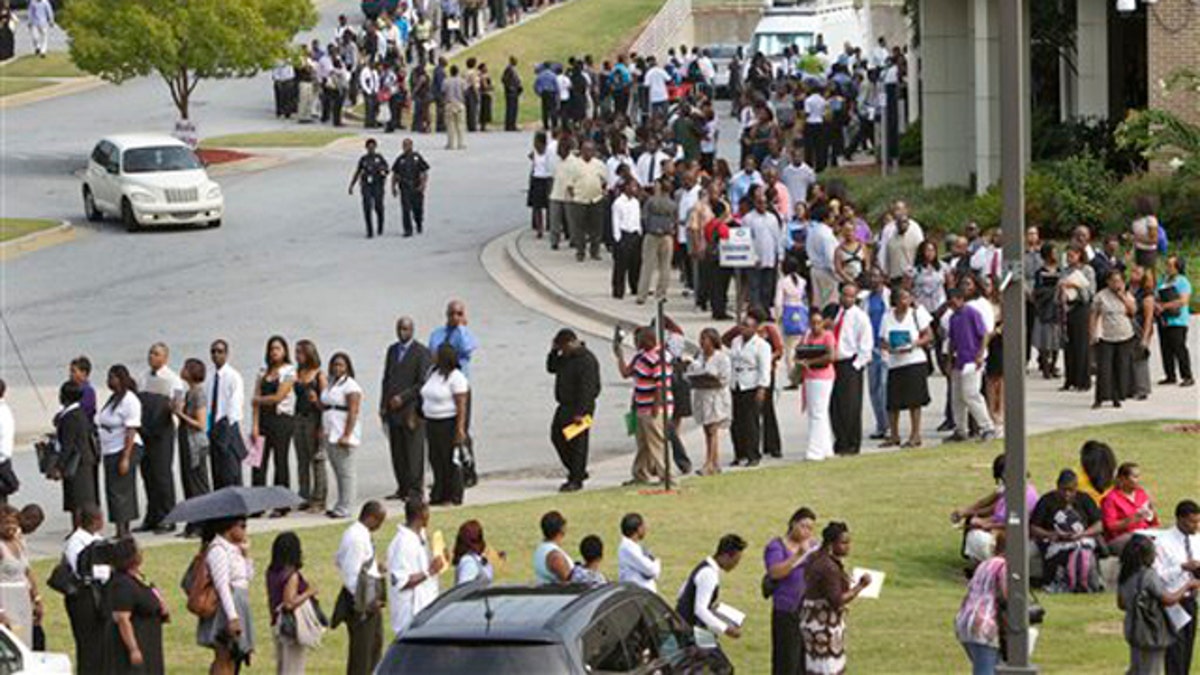
In this Aug. 18 file photo, people wait in line during a job fair in Atlanta. (AP)
More Americans were living in poverty in 2010 than at any time since at least the 1950s, with the overall poverty rate climbing to 15.1 -- a 6 percent jump in just one year -- according to Census figures released Tuesday.
The Census Bureau's annual report showed nearly 1-in-6 people in poverty, reflecting sustained long-term unemployment and the failure of the U.S. economy to kick into gear following a crippling recession.
The number of uninsured also edged up to 49.9 million, the highest in over two decades.
The figures cover 2010, and the jobless rate has not ticked down much since then. The unemployment rate stood at 9.1 percent in August. The report comes as President Obama tries anew to push legislation aimed at spurring job growth while providing government aid to those out of work.
According to the report, the number of people in poverty last year was 46.2 million, the largest number in the 52 years for which poverty estimates have been published. The overall poverty rate climbed to 15.1 percent up from 14.3 percent in 2009.
Based on percentages, it tied the poverty level in 1993 and was the highest since 1983.
Reflecting the lingering impact of the recession, the U.S. poverty rate from 2007-2010 has now risen faster than any three-year period since the early 1980s, when a crippling energy crisis amid government cutbacks contributed to inflation, spiraling interest rates and unemployment.
The situation has hit black populations the hardest, with their poverty rate rising from 25.8 percent to 27.4 percent. Child poverty rose from 20.7 percent to 22 percent.
The numbers show that a job is by no means a guarantee against falling into poverty. Among all American workers, the rate was 7 percent -- and 15 percent among those working part-time, a rate little-changed from last year.
And in a hallmark of what the officials dubbed "the boomerang generation," an estimated 5.9 million Americans between the ages of 25 to 34 resided at their parents' homes in the spring of 2011, when the survey was conducted. That's up 25 percent since 2007. Many of them would be living in poverty if they did not live with their parents, according to the Census Bureau.
The share of Americans without health coverage also rose from 16.1 percent to 16.3 percent -- or 49.9 million people -- after the Census Bureau made revisions to numbers of the uninsured.
That is due mostly because of continued losses of employer-provided health insurance in the weakened economy.
Congress passed a health overhaul last year to address rising numbers of the uninsured. While the main provisions don't take effect until 2014, one aspect taking effect in late 2010 allowed young adults 26 and younger to be covered under their parents' health insurance.
Brett O'Hara, chief of the Health and Disability Statistics branch at the Census Bureau, noted that the uninsured rate declined -- from 29.3 percent to 27.2 percent -- for adults ages 18 to 24 compared to some other age groups.
The median -- or midpoint -- household income was $49,445, down 2.3 percent from 2009.
Bruce Meyer, a public policy professor at the University of Chicago, cautioned that the worst may yet to come in poverty levels, citing in part continued rising demand for food stamps this year as well as "staggeringly high" numbers in those unemployed for more than 26 weeks. He noted that more than 6 million people now represent the so-called long-term unemployed, who are more likely to fall into poverty, accounting for than two out of five currently out of work.
Fox News' James Rosen and The Associated Press contributed to this report.




